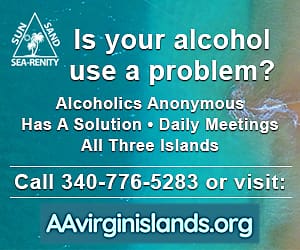A significant amount of sargassum seaweed may be prevalent across the tropical Atlantic Ocean and the Caribbean Sea throughout the year, according to a sargassum outlook from the University of South Florida (USF) Optical Oceanography Lab (OOL) released on Jan. 31.
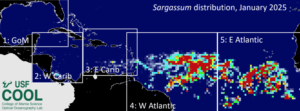
The OOL at USF, which monitors the presence of sargassum across the tropical Atlantic, Caribbean Sea, and Gulf of Mexico via satellite, has recently detected an increase in the amount of seaweed.
“As was predicted [in December 2024 by USF], total sargassum amounts in the tropical Atlantic (both western Atlantic and eastern Atlantic) continued to increase from December 2024 to January 2025 and remained negligible or very low in the Gulf of Mexico and western Caribbean Sea,” the USF update revealed. “Increased [sargassum] amounts were also found in the eastern Caribbean Sea, but [the] total amount still remained low,” USF said.
The spatial distributions [of the seaweed] in the tropical Atlantic remained stable, but [the] total amount [of sargassum] nearly doubled in a month, suggesting local growth,” USF noted. “Compared to most previous years since 2011, sargassum amounts in the western Atlantic and eastern Atlantic all exceeded each region’s 75th percentile [which is considered a high amount],” USF added.
Chuanmin Hu, Ph.D., a professor of oceanography and director of the OOLat USF, provided the Source with more information about the work the OOL is conducting.
“The OOL uses optical techniques to study algal blooms, oil spills, and general water quality at both local and global scales,” Hu explained. “Sargassum seaweed has optical properties distinguishable from water and, therefore, can be measured from [outer] space using satellite observations,” Hu said.
“Since 2016, the OOL has been generating sargassum maps for the Atlantic Ocean with daily updates available at the Sargassum Watch System (SaWs),” he added.
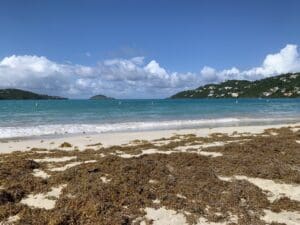
Sargassum — Explained
A previous Source article included additional information about sargassum through an interview with Yuyuan Xie, Ph.D., a research scientist at USF. Xie is also involved with the university’s OOL.
“Pelagic [or oceanic] sargassum seaweed is a brown macroalgae floating on the ocean surface,” Xie said. “It was first reported in the 15th century by Christopher Columbus, and a regional sea in the North Atlantic Ocean, the Sargasso Sea, was named after this plant. [Sargassum] serves as a habitat for many marine animals, such as turtles, fish, shrimp, crabs, and so on. These macroalgae can grow to a length of several meters and form floating mats on the ocean surface,” Xie continued.
Health Impacts
Sargassum has positive and negative benefits for the environment. Fortunately, the arrival of the algae is not extremely dangerous to people. However, there are some significant health risks.
“Most of the time, moderate amounts on beaches would not represent a risk factor for humans. However, there are exceptions,” cautioned Xie. “After a couple of days onshore, sargassum starts to decompose and release noxious and stinking gases such as ammonia and hydrogen sulfide. The bad smell can cause respiratory problems. There are reports that in some of the Caribbean Islands, the hospitalization rate has gone up during the sargassum season,” he said.
“Sargassum can be both good and bad for the environment. In the ocean it is a critical habitat for many animals, so they should like to see increased sargassum. Sargassum on beaches can also stabilize sand dunes, thus helping to avoid beach erosion. But too much of a good thing can also make it bad — excessive amounts of sargassum can also cause environmental and economic problems,” Xie added.
“There is no scientific consensus on exactly what caused the sargassum increases in the past decade in the Atlantic Ocean, but climate change may be part of the reason, as it affects precipitation, ocean circulation, and dust events, among others. This is still a research topic,” according to Xie. [The current predictions for a busy year of sargassum are based on statistical models rather than the exact causes of why the amount of seaweed is expected to increase.]
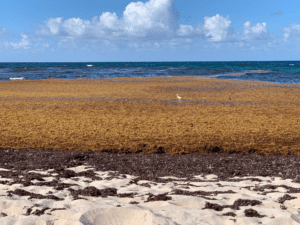
When Will Sargassum Arrive Across the Local Region?
According to the January 2025 sargassum update, residents and visitors across the Virgin Islands may soon begin to notice an uptick of seaweed as soon as February.
“As in most previous years, February is expected to see increased sargassum from January,” the USF report noted. “More sargassum is expected to enter the Caribbean Sea through the Lesser Antilles, [and] sargassum in the western Caribbean Sea and the Gulf of Mexico will likely remain very low,” USF said.
“However, the continuous and significant increases in total amounts of sargassum in the tropical Atlantic reinforce our earlier prediction that 2025 is likely another major sargassum year,” USF stated.
While more sargassum may begin to inundate the region in February, Hu said the Virgin Islands could be particularly affected by the seaweed starting in April.
“It is difficult to predict [exactly when a majority of the seaweed will reach the shores of the USVI], because local winds and currents play major roles in determining the timing of beach events,” Hu acknowledged. “The waters around the USVI, on the other hand, may start to receive relatively large amounts of sargassum around April [based on statistical predictions],” he continued.
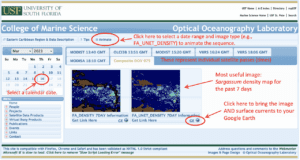
Sargassum Updates
Individuals can follow the progression of the current mat of seaweed and stay up to date each month on where sargassum may be headed.
“For the general audience, we’re generating a Sargassum Outlook Bulletin on a monthly basis, which can be downloaded via accessing our SaWS page,” Xie said. “This bulletin provides a general picture of the current bloom conditions and future bloom probability for the regions under watch. The SaWS system also provides satellite imagery every day for the current sargassum situation, where a user can download the images and surface currents,” Xie concluded.







